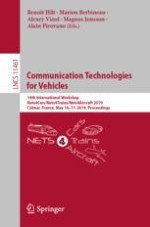2019 | Book
Communication Technologies for Vehicles
14th International Workshop, Nets4Cars/Nets4Trains/Nets4Aircraft 2019, Colmar, France, May 16–17, 2019, Proceedings
Editors: Benoît Hilt, Dr. Marion Berbineau, Prof. Alexey Vinel, Magnus Jonsson, Alain Pirovano
Publisher: Springer International Publishing
Book Series : Lecture Notes in Computer Science
